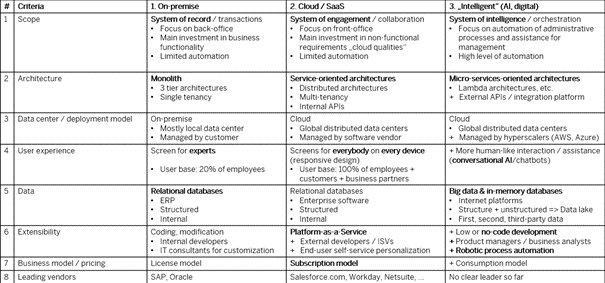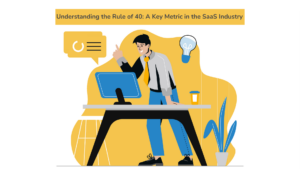Enterprise software has gone through a constant technology evolution in three phases. The SaaS era and related software vendors were disrupting the technology generation before, and the hypothesis is, that generated SaaS (Software-as-a-Service) will be disrupted and replaced by the enterprise software from the third generation, the intelligent enterprise software.
Enterprise software has gone through a constant evolution of technology evolution. Point Nine Capital has structured this evolution along three phases (1):
- On-premise
- Cloud / SaaS
- AI

Graph: Technology Waves in the B2B Software Industry (Source: Point Nine Capital)
We from valueworks.ai support this perspective, in particular as we confirm that there is a new and next generation enterprise software is arising and disrupting the current state of enterprise software. Every phase had its pioneers and category leaders.
- While the on-premise era had been led by SAP and Oracle,
- the SaaS era has been initiated and led by Salesforce.com, Workday and Netsuite.
- For the new era of intelligent enterprise software, so far, no leading vendor has been identified.
The following table outlines the differences between the three generations of enterprise software along the dimensions of scope, architecture, deployment model, user experience, data, extensibility and business model.

Graph: Differentiation of three generations of enterprise software
While it is common sense that the SaaS era and related software vendors disrupting the generation before, this article focuses on the hypothesis, that generated SaaS will be disrupted and replaced by the enterprise software from the third generation, the intelligent enterprise software.
Therefore, let us analyze the differences and especially the benefits that intelligent enterprise software creates versus the generation before along the following criteria:
Scope: While the era of SaaS brought a significant improvement of the usability and therefore enabled to broaden the user base from approx. 20-100% of the employees and even included customers, suppliers and business partners, the application has not (yet) been made more intelligent and more automated. That is the scope of the newest generation of enterprise software. On the level of transactional systems, topics like RPA (robotic process automation) or process mining provided the way to an automated digital backbone for the companies. On the level of analytics, we expect a revival of decision support systems for the management performing root-cause analysis based on big data and providing recommendations.
Architecture and Data: In order to leverage artificial intelligence requires the collection and processing of big data from internal and external data sources. Therefore, a relational database, even the in-memory version, is not sufficient, but needs to be complemented by a data lake including structured and unstructured data.
User experience: While in the history of enterprise software, the human being had to adapt to the machine with filling-out forms, the modern enterprise software behaves more like a digital assistant that more and more supports the human complementing with the machine skills and capacities. With chatbots and underlying conversational AI becoming very popular e.g. in the customer service space, the direction is set to a more human-like interaction with the enterprise software.
Extensibility: In order to scale much further beyond the traditional base of developers, it is crucial to enable no-code development capabilities. This enables the broad group of product managers and business analysts and consultants to quickly enhance the application to the needs of the customers in a most agile way – without cumbersome delays and costs from developers in the loop.
In shaping ValueWorks, we have clearly embraced the elements of intelligent enterprise software with the ambition to shape the category leader for Executive Management Software.






